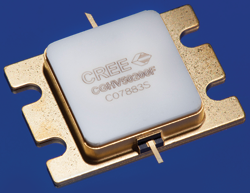
Troposcatter, satellite ground stations, and beyond-line-of-sight communication require high power — hundreds of watts to kilowatts — to overcome the high loss and variable propagation inherent in long-range microwave links. These C-Band applications have historically used traveling wave tube amplifiers (TWTA) or klystron power amplifiers to achieve the required power.
With the introduction of Cree’s new 200 W GaN HEMT, solid-state power amplifiers (SSPA) can replace TWTAs and klystrons for such applications while offering greatly improved performance. Previously, SSPAs combined a large number of lower power devices. Now, with a 200 W device, the SSPAs can be smaller and lighter, reduce hardware and operating costs and improve system reliability.
Product Description and Performance
The CGHV50200F is a 50 ohm GaN HEMT, internally matched at both input and output. The device was designed for high output power, efficiency and gain across a wide bandwidth. From 4.4 to 5 GHz, it provides over 200 W output at 48 percent power-added efficiency (PAE) and 15 dB small-signal gain. At 180 W output, the device can drive a load VSWR of 3:1 at all phase angles without damage.
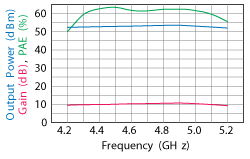
Figure 1 Pulsed performance of the GaN PA with a 43 dBm, 100 µs, 10 percent duty cycle input drive.
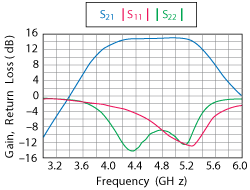
Figure 2 Input and output return loss, showing the quality of the internal matching.
The transistor is supplied in a ceramic metal-flange package (type 440215) with a flange size of 17.4 × 24 mm, not including the gate and drain leads. The surface area can dissipate 166 W at a maximum case temperature of 85°C. With 48 percent PAE, power consumption and heat dissipation are reduced, simplifying the electrical and mechanical design of high power SSPAs.
In a demonstration amplifier circuit, the device delivers 198 to 218 W (53 to 53.4 dBm) CW output power from 4.4 to 5 GHz, with 47 to 49 percent PAE and 11.4 to 11.8 dB power gain. Small-signal gain is 14.9 to15.1 dB. Figure 1 shows the pulsed performance of the device.
Figure 2 demonstrates the effectiveness of the input and output matching, with |S11| ranging from --4 to --12 dB and |S22| from --9 to --14 dB. Figure 3 shows the two-tone linearity versus output power with 1 MHz spacing of the test carriers. Third-order intermodulation distortion (IMD) is less than -22 dBc up to 100 W output, with fifth- and seventh-order IMD at progressively lower levels, which is expected for a transistor amplifier. With OQPSK modulation, linearity at 48 dBm output power is specified as -34 dBc at the middle of the frequency band. Figure 4 shows the OQPSK spectral mask at several frequencies.
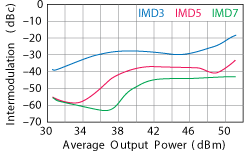
Figure 3 Two-tone intermodulation distortion with 1 MHz test signal spacing at 4.4 GHz.
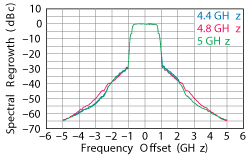
Figure 4 OQPSK spectral mask at 4.4, 4.8 and 5 GHz with the PA backed off to 48 dBm output power.
The amplifier’s typical drain bias is +40 V. The 125 V maximum drain-source voltage provides ample margin for peak voltages resulting from operating class, matching and modulation. The gate threshold voltage is typically -3 V, with the gate bias ranging from -2 to -3.5 V, depending on the desired class of operation.
A demonstration board
(CGHV50200F-TB) is available and enables easy evaluation of the device in a proven circuit. The board includes input and output connectors and transmission lines, DC blocking capacitors, decoupling stubs for drain and gate bias, bypass capacitors and a power connector. The printed circuit board is layered with a heat spreader that can be mounted on a cold plate or attached to a heat sink.
Targeted Applications
The main application for the CGHV50200F is tropospheric scattering or troposcatter. At C-Band, radio propagation is normally limited to line-of-sight. Ionized layers of the atmosphere do not efficiently reflect microwaves, and the short wavelengths are not refracted by the topographic features that allow lower frequency signals to reach beyond the horizon. Despite these limitations and depending upon weather phenomena, a small amount of C-Band energy will bend and scatter and pass beyond the horizon. Using the brute force of hundreds or thousands of watts, reliable communication can be achieved at distances much greater than a typical microwave path.
Satellite communication is the other major C-Band application that requires significant transmitter power. Higher power amplifiers enable smaller antennas at the earth station and increase the reliability of the link.
A high power transistor such as the CGHV50200F allows designers to build SSPAs with fewer devices, which greatly simplifies power combining, device gain matching and DC power distribution. The device also has the linearity for OQPSK modulation when operated “backed off” at 100 W average output power.
Cree Inc.
Research Triangle Park, N.C.
(919) 407-5302
www.cree.com/RF
